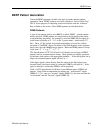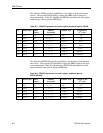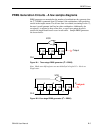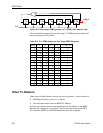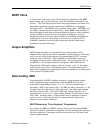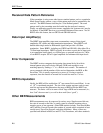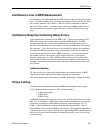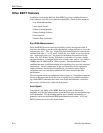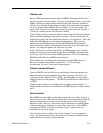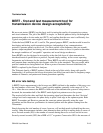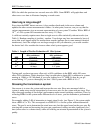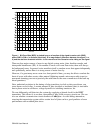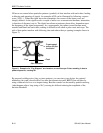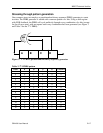
BERT Primer
GB1400 User Manual B-11
Pattern Lock
Before a BER measurement can be made, the BERT Transmitter and Receiver
must be using the same test pattern. This may be guaranteed if they use the same
PRBS or fixed word pattern and are running at the same clock rate, but there is
still the issue of having the bit comparison begin at the same point in the pattern.
All of our general purpose BERTs have the ability to do an “auto search” for
pattern lock. There are two techniques commonly used for this: the “bit slip” or
“clock slip” method, and the “feed forward” method.
In the “bit slip” method, each error detected causes a one-bit slip in the reference
pattern, until the beginning of the pattern is reached. This is normally the only
method that can be used with custom data structures or word patterns. This is the
method the GB1400 uses to synchronize any data pattern. This is also the
method used for WORD patterns with the GB700 and GB1400 instruments.
With the “bit slip” method, synchronization times will vary by the length of the
pattern. The longer the pattern, the longer the sync time.
In the “feed forward” method, which works for PRBS patterns only, a certain
number of arriving bits are latched into the Receivers PRBS shift register and
used as the “seed” for the start of the PRBS generation. This is the method the
GB700 and GB1400 use for PRBS synchronization.
Both methods rely on realizing some minimum acceptable BER before the
Receiver considers it has obtained “pattern lock”. It will then begin
accumulating “bit errors” in the error counter register.
Pattern Loading Software
Almost all BERTs have the ability to accept loading of reference patterns into
internal memories in both transmitter and receiver. In many cases this is via
computer interface, either RS-232 or GPIB. The GB1400 has an front panel
floppy disk drive to load patterns. The GB700 and GB1400 use either RS-232
or GPIB.
Pattern creation software is a valuable aid in developing custom patterns. A
simple spread-sheet like tool is available for our BERT products to help with this
need.
Error Insertion
Most BERTs have the ability to internally generate bit errors, either singly or at
specific bit error rates. This calls for altering bits in the output pattern which are
opposite from the bits the receiver will use at that location, thus causing the
Receiver to tally a bit error. This feature may be important in measuring ability
of device under test to withstand or recover from such errors. Some BERTs,
including our GB700, will allow an external “trigger” signal to cause an
immediate bit error to be output.
Error insertion is also a useful tool to test the “integrity” of your equipment
setup. You should always insert a few errors in your setup to conform correct
operation before you start your data collection.



